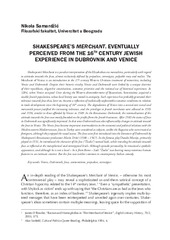Приказ основних података о документу
Shakespeare’s Merchant. Eventually Perceived from the 16th Century Jewish Experience in Dubrovnik and Venice
| dc.contributor | Agičić, Damir | |
| dc.contributor | Petrić, Hrvoje | |
| dc.contributor | Šimetin Šegvić, Filip | |
| dc.creator | Samardžić, Nikola | |
| dc.date.accessioned | 2023-05-03T13:41:58Z | |
| dc.date.available | 2023-05-03T13:41:58Z | |
| dc.date.issued | 2019 | |
| dc.identifier.isbn | 978-953-175-707-2 | |
| dc.identifier.uri | http://reff.f.bg.ac.rs/handle/123456789/4389 | |
| dc.description.abstract | Shakespeare’s Merchant is a peculiar interpretation of the Elizabethan era mentalities, particularly with regard to attitudes towards the Jews, almost exclusively defined by prejudices, stereotypes, palpable envy and malice. The Merchant of Venice is an introduction to the 17th century Western Christian treatment of minorities, including Venice and Dubrovnik. Despite their historic rivalry, Venice and Dubrovnik were linked by a unique doctrine of their republican, oligarchic constitutions, economic priorities and the rational use of historical experiences. In 1204, when Venice occupied Crete during the Western dismemberment of Byzantium, Serenissima acquired a sizable Jewish population, whose local history was rooted in antiquity. Such experience has probably generated their tolerance towards Jews that, later on, became a reflection of realistically unfavorable economic conditions in relation to trade development since the beginning of 16th century. The degradation of Venice into a second-rate naval and mercantile power justified the increasing tolerance, and the privileges to Jewish merchants were allowed in 1593 and 1594, similar to those afforded by Venice in 1589. In the Renaissance Dubrovnik, the rationalization of the attitude towards the Jews was mostly founded on the profits from the Jewish businesses. After 1583 the status of Jews in Dubrovnik was significantly improved. In that sense Dubrovnik was also influenced by changes in attitude toward the Jews in Venice. The Venice Jews became important intermediaries in the economic and political relations with the Muslim eastern Mediterranean. Jews in Turkey were considered as subjects, unlike the Ragusins who were treated as foreigners, although they enjoyed the vassal status. The Jews were first introduced into the literature of Dubrovnik by Shakespeare’s Renaissance predecessor Marin Držić (1508 – 1567). In the famous play Dundo Maroje, primarily played in 1551, he introduced the character of the Jew (“Žudio”) named Sadi, while revealing his attitude towards Jews as reflected at the metaphorical and stereotypical levels. Although episodic personality, he remained a symbolic appearance, and although he is not a local – he is from Rome – Sadi “Žudio” was bearing many notorious human features in an intimate content. But the Jew was neither common in contemporary Italian comedy. | sr |
| dc.language.iso | en | sr |
| dc.publisher | Filozofski fakultet Sveučilišta u Zagrebu | sr |
| dc.rights | openAccess | sr |
| dc.rights.uri | https://creativecommons.org/licenses/by/4.0/ | |
| dc.source | Zbornik Drage Roksandića | sr |
| dc.subject | Venice | sr |
| dc.subject | Dubrovnik | sr |
| dc.subject | Jews | sr |
| dc.subject | antisemitism | sr |
| dc.subject | prejudices | sr |
| dc.subject | stereotypes | sr |
| dc.title | Shakespeare’s Merchant. Eventually Perceived from the 16th Century Jewish Experience in Dubrovnik and Venice | sr |
| dc.type | conferenceObject | sr |
| dc.rights.license | BY | sr |
| dc.citation.epage | 422 | |
| dc.citation.spage | 413 | |
| dc.identifier.doi | 10.17234/9789531759021.28 | |
| dc.identifier.fulltext | http://reff.f.bg.ac.rs/bitstream/id/10761/28.pdf | |
| dc.type.version | publishedVersion | sr |

